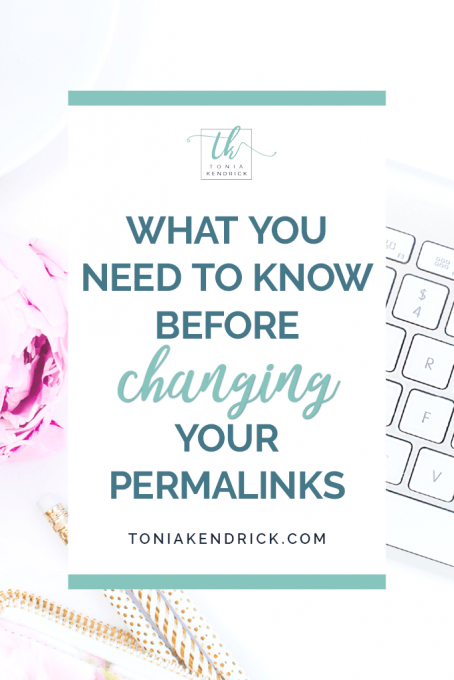What You Need to Know Before Changing Your Permalinks
I did something dumb, and what’s worse I knew better. I changed the permalinks on my blog without thinking through the consequences.
This post is a cautionary tale. Read it before changing your permalinks and you won’t make the same mistake I did.
And if you did make the same mistake I did, I’ll tell you how to fix it.

This post contains affiliate links, which means I receive a small commission if you make a purchase using this link. For more information, see my full disclaimer here.
What is a permalink?
First, let’s define permalink, so that everyone is on the same page. Permalinks are the permanent URLs on your blog. There will be a permalink for each blog post, each category, each tag, each page, etc. Permalink is short for permanent link – which implies that the permalink should never change.
WordPress gives you several different permalink styles to choose from. You generally make a decision about your permalink style when you set up your blog and then leave it alone.
This screenshot shows a permalink example from a post at my genealogy blog, Tonia’s Roots. You can see that it points to a specific post and that it also includes some additional information, namely the date that the post was published.

Why I changed the permalinks on this site
When I set up this blog, I patterned a lot of the structural choices after what I had done at Tonia’s Roots, including the permalink style, which includes the date.
However, the trend is going away from including dates on blog posts, especially for those with evergreen (i.e. timeless) content. The only place that dates appeared on this blog was in the permalinks and I had been thinking about removing them.
Then I read a blog post a few days ago that suggested removing a number of things from your website, including dates. I made a spur-of-the-moment decision to change my permalink style.
Consequences
When you change you change your permalink style, then every link to your blog is messed up. That includes backlinks that you have added in posts referring to older content. That includes every post you have tweeted or added to your Facebook page. That includes every single pin that you or someone else has added to Pinterest. And so on and so on.
As you can see, there are consequences to changing your permalink style. I’m not saying you shouldn’t change your permalinks, but you need to think about it beforehand and be prepared to deal with the aftermath.
How to change your permalink style
If you decide to change your permalink style, then do this first. Install the Redirection plug-in on your WordPress blog. Redirection will automatically create 301 redirects when you change a post URL. That means that it will automatically forward your visitor from the old URL to the new URL and your visitor won’t see the dreaded 404 error page. This will save you a lot of headaches.
Next, go into WordPress Settings, click on Permalinks, and choose the new permalink style that you want to use. I changed my permalink style from “Day and Name” to “Post Name.”

Click Save Changes before you leave the page.
More help from the Redirection plug-in
If you changed your permalinks before installing the Redirection Plug-In, it’s not too late. Redirection can still help you, but it will take more intervention on your part. You will need to create the 301 redirects from the old URL to the new URL. This is easier than it sounds.
There are several WordPress plug-ins that will help you create 301 redirects. I chose Redirection, because it also captures data on 404 errors. I knew that in order to catch all the bad links, I would need a 404 checker and Redirection lets you create 301 redirects directly from the 404 errors.
After you install Redirection, you will access it from Tools. Click on the link for 404s. This will pull up a list of all the 404 errors that have been served up to your visitors.
When you mouse over an error, a link will appear to Add redirect.

Click on the link. It will prefill with the bad URL – the one that caused the 404 error. You will enter the new URL. You can copy and paste this from the URL bar at the post’s new location. You don’t need to include the domain name. Then click Add redirection.

Plug-in downsides
There are some downsides to using a plug-in for 301 redirects.
- It could cause your site to load more slowly (this is true for any plug-in, not just those that redirect). There can also be a small (micro-second) delay in the page-load time for the redirected URL.
- If you ever decide to remove the plug-in, then all the redirects will be gone and you will have 404 errors again. You can download the redirects to a csv file, so be sure to do that should you decide to delete the plug-in. Then you have a record that you can use to set up the redirects again.
- Lastly, and this is specific to Redirection. . .it continues to log 404 errors for a URL even after you set up the 301 redirect. This doesn’t cause performance problems, but it is annoying.
Even though there are some downsides, I recommend going with a plug-in. The alternative is to add the redirects directly to your .htaccess file, which you shouldn’t touch unless you really know what you are doing.
Changing the permalink style on your blog is a big change. Think through the consequences before you click the button.
If you decide to move forward with changing your permalinks, then be prepared. Install Redirection or another redirect plug-in before you start. If you have already changed your permalink style, then use the tools from this post to ensure that your readers see your content, rather than the 404 error page.
Want to remember this? Save What You Need to Know Before Changing Your Permalinks to your favorite Pinterest Board.

Related posts:
- How to Start a Blog With WordPress & Siteground
- How to Use a Spreadsheet to Organize Your Content Ideas
- 9 Tips to Help You Punch Through Writer’s Block
- 20+ Totally Free Blogging Resources
- Do You Know Your Blogging Personality? – Free quiz!
Free Workbook!


